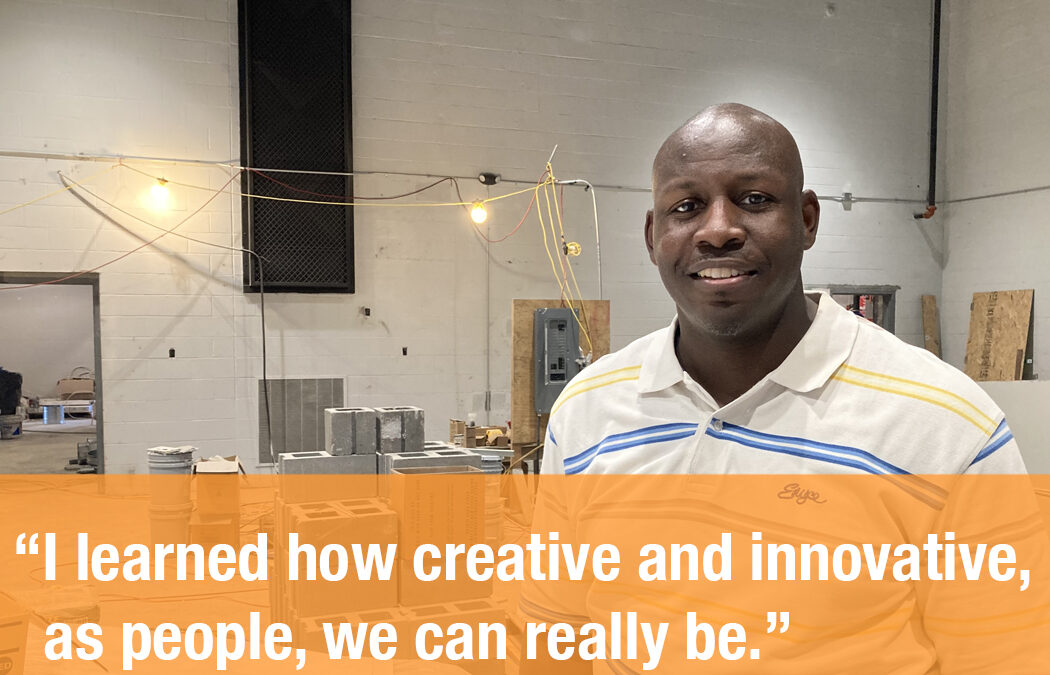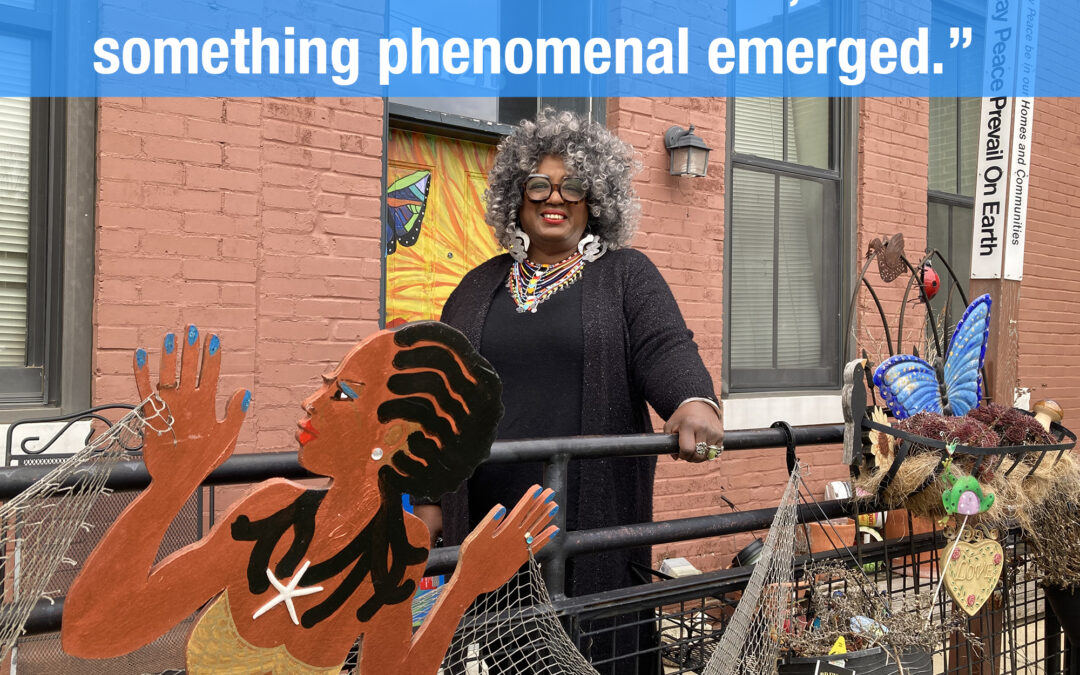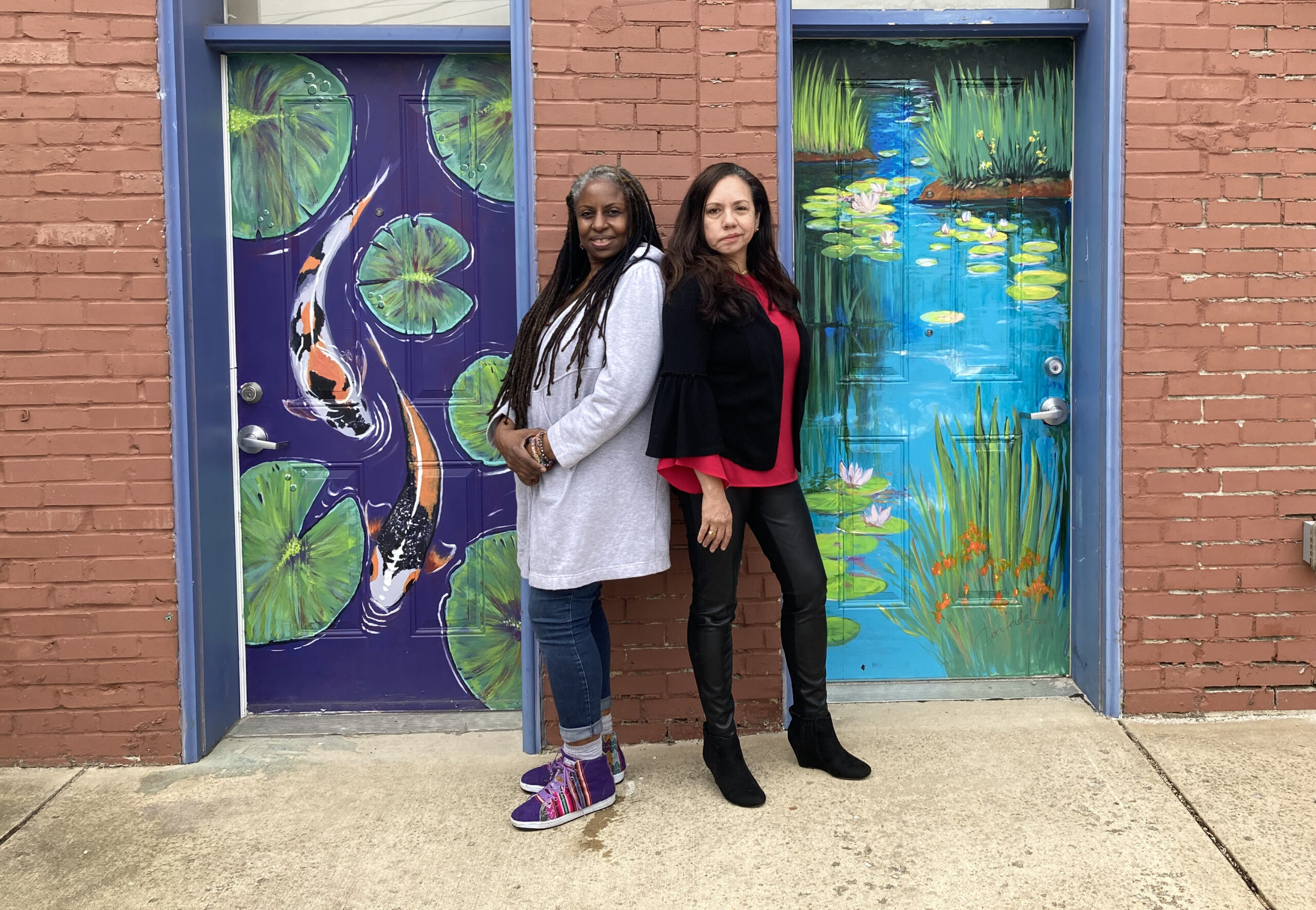Neighborhood Reflections On 2020, O’Fallon — Growing and Developing Community on West Florissant
This spring Invest STL is taking time to lift up voices, stories and neighborhoods to help us reflect on 2020 and celebrate some of our brighter moments of connection and impact in St. Louis neighborhoods. We sat down with some of our partners to look at their highly collaborative and responsive work spawned by the newly created Neighborhood Solidarity Fund and the urgent needs 2020 amplified in the community. Each Monday, over the next few weeks we will introduce a neighborhood leader to share perspective on what 2020 looked like in their neighborhood and how they were able to remain hopeful in the face of challenging times.
Karen Greer, a Small Business Lift investee is the owner of Angels Within CDS Home Health Care, LLC. Karen is working out of the 21st Ward in North City, St. Louis, which is also in an Opportunity Zone. It is a challenging place to own a business, but Karen sees a lot of potential and she is expanding her footprint as a result. Despite the nature of 2020 and how the pandemic affected her, Karen has a deep commitment and drive to be a positive force in the O’Fallon neighborhood.
During the rise of the pandemic she used her business, resources, and connections to supply clients, staff, and the community with critical PPE. For Karen the value goes beyond the immediate health and safety support her organization provided — there is a bond in giving and receiving,
“The benefit was that we got more trust from people. To know that they had support, a resource, that the door was open. It’s building growth, it’s social growth and it’s a resource, so they know exactly where to go.”
CLICK HERE TO LEARN MORE AND GET THE WHOLE CONVERSATION WITH KAREN
“The people pulling together! I mean, just the connectivity, you know, when there is a cry for help, I’ve seen a lot of people come together.”
— Karen Greer
The following conversation took place over Zoom in mid-February of 2021, between Michael Pagano and Karen Greer, who is a business owner and community developer in the O’Fallon neighborhood. This conversation has been edited for length and clarity.
Michael:
Thanks again for spending some time with me today. As you know, Invest STL is connecting with neighborhood partners and community leaders to join us in reflecting on 2020 and part of our emerging philosophy is really to step back and listen to our community partners and help amplify and lift up the good work and experiences that you have had and the work that you are doing. We also wanted to broaden the focus a little bit and really highlight your human experience throughout the year that 2020 was.
Whether you were able to adapt and really thrive, or if maintaining and surviving was the way that we can view success as well. I’d like to start with some of the basics, if you could introduce yourself and share your organization and which neighborhood you are in.
Karen:
Hi, I’m Karen Greer, and the name of my agency, it’s a home health care agency, is Angels Within CDS Home Health Care, LLC and we are working out of the 21st Ward in North City, St. Louis, which is also an Opportunity Zone. I also want to mention that I am a Neighborhood Leadership Fellowship with UMSL, the 2020 cohort. They guided and helped me grow in my community involvement. I am so thankful for that experience.
Michael:
That’s super. Tell me a little bit about your organization and the work you do.
Karen:
Right now, I’m a home healthcare agency. We are like the middle person between Medicaid and the client. They are considered either the client or the employer, they hire who they want to work in their home. We oversee that operation, making sure the employees are properly background checked and qualified to work for that client and receive state benefits from that. So we make sure that those background checks are done on a quarterly or monthly basis. We make sure that the client is getting the care that they need at their home by doing monthly checks. Making sure during this COVID time that they are receiving PPE that we are getting from the state. I am helping supply my clients and my staff as well as community. We make bags to distribute to those who are homeless and walking the streets, anyone we see we will give supplies. It is much needed in this community. The 63115 zip code was a hard hit for the underserved people in the community. We distribute those PPE supplies as much as needed. We make calls and coordinate drop offs and pickups.
Michael:
And that distribution work, you do it yourself and your staff as well? Is that kind of an all hands on deck situation?
Karen:
Yeah, pretty much. Yes. So we do it as much as needed. We are even making calls to people, if they needed anything, I was doing drop offs and having their employees come by for pick up as well. So it worked out pretty well.
Michael:
Tell me about your NSF Small Business Lift grant concept and how you were able to gain support for your business through that?
Karen:
With the grant support we were able to bring in another person temporarily to help manage clerical work, cleaning, coordinating and preparing PPE distribution. We did get some more computers in order to support that staff work and used the funds to support that COVID-19 preparation effort.
Michael:
Can you speak to the broader impact on the community that all of this effort had? The way that the community was able to benefit by your ability to maintain and grow that capacity during such a hard time.
Karen:
The benefit was that we got more trust from people. To know that they had support, a resource, that the door was open, and they shared the resource, so anybody that needed masks, instead of going to pay for them, they were able to get them for free. As well as a spinoff of doing a toy drive around the holidays. It’s building growth, it’s social growth and it’s a resource, so they know exactly where to go.
Michael:
That’s excellent. That’s just the type of insight that we want to lift up and highlight and share. I think a lot of the work that we are doing to improve our communities, that trust is a foundational piece of that. And anywhere that we are able to put our actions behind our words, I think that’s a big piece of how trust either gets built or repaired in different cases. So I appreciate hearing that.
Karen:
There were a lot of collaborations and bonds that were formed through sharing these resources and knowing that in this time of need everyone was pulling together. We had a lot of the smaller organizations that I was able to learn about. Because I don’t live there, in O’Fallon. I am a business owner, doing a big development now in that community. I am learning to connect and collaborate with these other organizations and be a resource to them as well.
There was an organization giving out school supplies at the YWCA, and the YWCA was another partnership where I collaborated with the 77th State District Rep. Kimberly Ann Collins, she did the first toy drive there, I assisted with that as well as provided some of the supplies that I had. It was really fun that we were able to collaborate and give the kids gifts during that time. That is how I ended up doing my toy drive, to use the surplus. We wanted to make sure that the kids in the community were happy during this time. I also met people like Pastor Rebecca Smith, who does a lot of work with the homeless, I met here through the school supply drive as well.
Michael:
Those all sound like wonderful ways to serve and connect and grow in the neighborhood, in the community that you are with as a business owner and developer. What inspired you the most throughout the process? Can you take a second to step back? Is there an anecdote that kind of sums of that inspirational quality?
Karen:
The people pulling together! I mean, just the connectivity, you know, when there is a cry for help, I’ve seen a lot of people come together even though there are some differences, we all have that common goal to make sure that everybody in the community is okay or to check on people to make sure their needs are met. So I think that pulling together is it. And seeing that the kids are benefiting, that’s the joy, so they won’t get “crowded” with all this pandemic.
Michael:
Seeing the kids benefit really does bring you joy. I can see that. As a business owner, it has got to have been a very dynamic and tumultuous year full of a lot of stress and unknowns, but where were you able to find hope throughout this last year?
Karen:
That was hard. Just keep pushing through, I pray. Thank God that I wake up everyday, to have the strength to do it again. To help somebody else because it could be me. So as long as I have breath I am going to keep doing it everyday.
To look and see so many people around me that are affected by this pandemic and whether it’s the pandemic or mental illness, a lot of people just can’t handle it. It’s a tear breaker. For me, I have clients who are going through it as well and I have to give them some comfort as well, so I have to be strong even though I had COVID. Mine was not severe, but the scare of it, that it could be. So I know that feeling of knowing that someone will actually be there for you.
Michael:
That support is essential. I’ve just got one more question for you here before we wrap up. Were there any surprises or unexpected challenges you faced as a business owner?
Karen:
Growth in real estate. During my journey as a business owner I experienced bankruptcy, hardship, especially as a single parent, a single mom, and I’m still a single mom of two. I have struggled being a business owner in a low income area, where it’s divided, but I work to overcome that and still have a vision to help the community, beautify it, bring in resources, and whatever help that I can.
I obtained one city lot from the LRA before COVID hit and then right as COVID was hitting, I closed on the second lot, which gave me 6 out of the 10 lots on the block. I already had my agency there and another lot there. Fortunately, I closed on the last building on that block, so now I own 8 out of 10 lots on that block. So that’s pretty much 90% of that block. So now I’m developing that for the community to turn those lots into a farmers market where any of the local residents that are growing their own food, the urban growers, when they have a surplus of food that they want to sell, and they want to make a living by selling that produce, they can do it right there on that lot. So they would have first opportunity to lease space and then we would fill that space with outside vendors to serve fresh fruits and vegetables and what not. It’s to give them an opportunity to earn some money in that space. And then with the building, that community doesn’t have any office space. It’s a two story building, on the top two-thirds is going to be leased office-shared space, and one apartment.
On the lower level, is going to be a banquet hall because two blocks over, right before you get to the now historic O’Fallon Park there is a growing community of residents and soon to be a variety of businesses. So there is plenty of space to host and hold events. On that last corner of the building is going to be a soul food restaurant that is going to serve healthy food as well as the fresh produce that is coming right off that lot. It gives the community a boost of economic resources, bringing more people into the community, bringing people together in one location to socialize and have a bond. Start building bonds, start building trust with each other and then be able to network and grow out of that.
Michael:
That’s excellent. Can you just refresh my memory? The block you are talking about is on West Florissant?
Karen:
Yes, 4108 West Florissant Ave. And actually a week ago I just found out that 81 Million Development is in the O’Fallon neighborhood. It’s 10 blocks that they are going to be redeveloping and I’m right there in that area.
Michael:
Fantastic. It sounds like you are in a really good position and showing quite a bit of leadership as well.
Karen:
It was all unexpected, so that’s the good thing about this growth out of a bad situation.
Michael:
Karen, thank you so much for your time today and sharing your story with us. I look forward to keeping the conversation going. I’d like to check back in with you down the road and hear about the developments and how things are progressing as you continue to nurture the block.
Karen:
Yes! I’m excited and I’m energized. That’s another thing that gets me up and keeps me up.
I’m ready to see the community shine.



